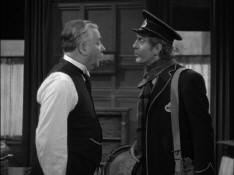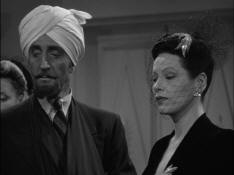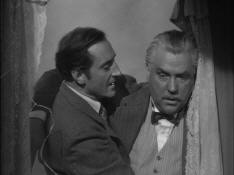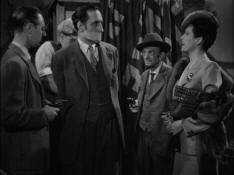The
Spider Woman
|
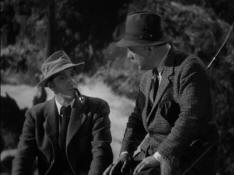 On holiday in Scotland |
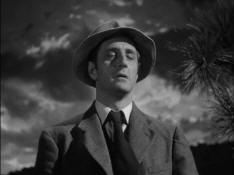 Holmes faints! |
A rash of crime follows the publicized death of Sherlock Holmes. Inspector Lestrade even admits that he misses Holmes, and he berates Watson for allowing Holmes to fall. Holmes returns to Baker Street disguised as a postman bearing a package for Sherlock Holmes. He mutters about Holmes not being very clever, and provokes Watson into slugging him!
After Watson hits him, Holmes laughs and tells Watson who he is. Watson is both overjoyed that Holmes is alive, and hurt and angry that Holmes tricked him. Holmes explains that it was his plan to investigate the "Pajama Suicides" incognito. He is convinced that the victims were driven to suicide, and he suspects a woman — "a female Moriarty ... clever, ruthless and cautious." He believed that the criminals would become careless if they thought he was dead. Holmes has discovered an important clue: all of the victims were fond of gambling.
|
Sherlock Holmes and the Spider Woman With apparently more original angles and certainly more thrills and suspense, this adventure of the famous detective is easily the topper of the Universal series of chiller mysteries. Although death stalks more freely and there are more heroics in the situations, there seems to be less corn and somehow more believability than usually used in the formula. Sherlock Holmes traces several suicides to the activities of a certain lovely lady whom he discovers uses poisoned spiders to bring about self destruction. In getting the evidence on her, he cheats death by a narrow margin on at least three occasions—a gas attack in his apartment, at the tentacles of a giant spider, and as a human target in a shooting gallery. Basil Rathbone seems less movie and more on the acceptable Doyle side which places him to far better advantage. Accordingly, it is his best detective performance to date. And Nigel Bruce's Dr. Watson sparkles a bit brighter—perhaps because of more restraint and less huff-puff dynamics. Gale Sondergaard's portrayal of the title role for menace is outstanding in beauty and charm as well as convincing performance. Chalk this one up as the best of the Sherlocks. —The Independent Film Journal, January 22, 1944 |
Disguised as Rajni Singh, an Indian just arrived in London, Holmes visits a casino. He meets a beautiful woman there named Adrea Spedding. Together they manage to lose all his money, and he says his life is ruined. Miss Spedding offers him a solution to his financial woes; borrow on a new life insurance policy that a friend of hers will issue right away. All he needs to do is name her friend as the beneficiary.
When Rajni Singh visits her apartment, Adrea Spedding quickly figures out that he is in fact Sherlock Holmes. That night, as "Rajni" sleeps, a spider crawls through the ventilation into the room and over the pillow to the victim. Holmes is of course prepared and kills the spider. He consults an expert and learns that the venom from this particular spider causes excruciating agony — so much that the bite victim is driven to self-destruction. But Holmes still lacks the proof that Adrea Spedding is behind the murders, and there are some unexplained footprints — small and child-like.
Later, Adrea Spedding visits 221B Baker Street and tries to throw Holmes off the right track by bring a child with her. Adrea tries to poison Holmes by having the child throw a candy wrapper in the fire as they are leaving — a candy wrapper containing "Devils Foot," a rare vegetable poison from Central Africa. The room quickly fills with smoke, and Watson is overcome, but Holmes manages to get himself and Watson to a window, and fresh air, just in time.
The clues lead Holmes and Watson to the home of a collector of rare and exotic insects, whom Holmes believes supplies the deadly spiders to Spedding. But Holmes finds that the man has been murdered and replaced by an impostor. The impostor escapes. Holmes discovers the skeleton of a pygmy and realizes that it was a pygmy, not a child, who crawled through the ventilation shafts to release the spider into the victim's room.
Having traced the pygmy to a carnival, Holmes and Watson spot Adrea Spedding entering a fortune teller's booth. Holmes follows, but Spedding is waiting for him and he is captured. Knowing that Watson and Lestrade are out front shooting at the figures in the shooting gallery, Spedding's pals tie Holmes behind a Hitler figure, hoping that Watson will unwittingly shoot his own friend. Fortunately, Holmes escapes in time, and Spedding and her friends are arrested.
|
Holmes and the Spider Woman A touch of horror makes this one of the best of the Sherlock Homes series of melodramas. The story has been worked out with considerable suspense without losing any of the pleasantly humorous touches that have come to be expected of a film that throws Sherlock and his pal, Dr, Watson, together. Using a story by Sir Arthur Conan Doyle as a foundation, Bertram Millhauser has built an entertaining and exciting tale of black villainy. Holmes' bait this time is a series of deaths listed as suicides. Our sleuth cries murder and sets out to prove it. what is more, he is certain a woman is at the bottom of the dirty work. How he goes about proving his case is quite interesting, not to say deucedly clever. It doesn't take long to find his woman—thanks to his disguising himself as a rich officer in the Indian army. The lady makes the mistake of trying to give the "Indian" the business. The woman's racket is to loan a prospective victim money on his life insurance and then getting a venomous spider to put the bite on him. Unable to bear the agony, the fellow then obligingly does away with himself. Neat, hey what? Sherlock falls into the clutches of the villainess and her cohorts and is almost "done in" by a diabolically ingenious means before the lady and her boys are brought to boot. Roy William Neill has acquitted himself well as producer and director. Basil Rathbone gives his standard performance as Sherlock. Nigel Bruce again is good for many chuckles as Watson. Gale Sondergaard plays the villainess acceptably. Inspector Lestrade once more is enacted nicely by Dennis Hoey. DIRECTION, Good. PHOTOGRAPHY, Good. —The Film Daily, January 13, 1944 |
Filming began May 10, 1943, and wrapped up in June 1943. The film had limited release in select USA markets on December 24, 1943, and general release in the USA on January 14, 1944.
Exhibitors were encouraged to promote the film with the title The Spider Woman to emphasize the horror aspect of the film. If they felt their audiences had been following the Sherlock Holmes series with enthusiasm, exhibitors could promote the film as Sherlock Holmes and the Spider Woman.
The plot ignores the fact that insurance companies do not pay out when the insured commits suicide. So what did Adrea Spedding have to gain by her victims' deaths?
The Spider Woman is allegedly based on The Sign of Four, but the only similarity I can see is that fact that a pygmy was involved in the murder. (As you may remember from The Sign of Four, an aborigine from the Andaman Islands killed Bartholomew Sholto with a poisoned dart from a blowpipe.) The use of the poisonous powder in the fireplace is of course taken from "The Adventure of the Devil's Foot" (the story of the Cornish Horror). Rathbone gives his usual, excellent performance as Holmes in this highly entertaining mystery.
A later film, The Spider Woman Strikes Back (1946), was made with Gale Sondergaard, but did not include Rathbone.
Gale Sondergaard made a personal appearance at a screening of The Spider Woman by the Academy of Motion Picture Arts and sciences in 1981. During a question and answer period that followed the film, someone asked her how she developed the character of Adrea Spedding. She responded, "The spider woman character as scripted had no hint of background or motivation, and I had no concept of how to play her as a three dimensional character. I mean what kind of childhood could she have had? Ultimately I chose to play her as Holmes' equal and allow their battle of wits to be played out much like a female Moriarty." (quoted by Michael A. Hoey in Sherlock Holmes and the Fabulous Faces, 2011)
Besides The Spider Woman, Basil Rathbone and Gale Sondergaard appeared together in The Mark of Zorro (1940), The Black Cat (1941), and Paris Calling (1941).
The following actors who appeared in The Spider Woman also appeared in other Sherlock Holmes films:
- Vernon Downing (Norman Locke) also appeared in Sherlock Holmes Faces Death.
- Harry Cording (Fred Garvin) also appeared in The Voice of Terror, The Secret Weapon, The Pearl of Death, The House of Fear, Terror by Night, and Dressed to Kill.
- Arthur Hohl (Adam Gilflower) also appeared in The Scarlet Claw.
- Alec Craig (Radlik) also appeared in The House of Fear.
- George Kirby (news vendor) also appeared in The Scarlet Claw.
Angelo Rossito, who played the pygmy, was a white man wearing blackface. He also appeared with Rathbone in The Magic Sword (1962).
See more photos and reviews on Page Two. See Posters, Lobby Cards and Promo Photos on Page Three!
|
.
| Images on this page and page two are from the film The
Spider Woman.
|
The
Spider Woman is available on DVD: Click to order |
DVD also available as
part of The Sherlock Holmes Collection, Volume 2: Click to order |
.
|
|







